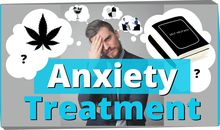What is Pure-O?
It may sound like some new form of recreational drug, but Pure-O is actually a rare form of OCD.
Most people who have this, don’t realise it.
If you were a mum and kept having thoughts about drowning your baby, or a teenage boy thinking about having sex with your sister a few dozen times a day – who are you going to talk to about that?
You’re probably going to hide it.
Keep it a secret for years, maybe your whole life.
Would you assume that the reason you have a sudden sexual image of your sister is because you have a psychological condition that misinterprets random, harmless thoughts as dangerous intentions and desires?
You’d probably think you had serious unforgivable issues and are a terrible person.
“I can’t believe I’m thinking that!”
You might Google to find out what this means.
Deliberately conjure up mental images of your sister while monitoring your feelings:
Am I aroused or repulsed?
Excited or horrified?
You might avoid her, or family gatherings.
Maybe spend many hours a day in a spiral of rumination and problem solving, trying to figure out what is wrong with you and how to fix it.
Unfortunately, all of these attempts to rid yourself of doubt and worry are compulsions. Which maintain the problem.
Normally OCD consists of recurring intrusive thoughts (obsessions) and behaviours that the person carries out to nullify these obsessional thoughts (compulsions).
Pure-O, is not considered to be separate from OCD.
It was coined to describe a kind of OCD where the person seems to have only obsessions and no compulsions.
However, this is not actually what’s happening.
With Pure-O, you’re still trying to counter the obsessional thoughts with compulsive behaviours, it’s just that the behaviours are internal.
They’re thought-based.
HUH? How does that work!?
Well, let’s use a couple of examples.
Let’s say you were having an intrusive obsession - an image of stabbing someone you care about with a knife.
This is absolutely not what you want to happen and are afraid of it coming to pass.
So you try to prevent it by checking in with your feelings perhaps…
Any anger towards that person?
I’m not sure… maybe?
What if there is?
I can’t be sure…
I better keep thinking about it until I’m certain there’s no chance of it happening.
But the doubt lingers.
Sexual orientation doubts are common among straight and gay sufferers of Pure-O.
The mental anguish and experimentation involved can resemble a coming out process, so they often get misinterpreted by sufferers, and by those around them.
It can even happen when you have nothing against being another orientation.
But you still end up terrified.
This is because of the feelings of doubt and the belief that you need certainty to be safe.
You must know your identity, what kind of person you are.
And to feel sure of this, to move on.
Which feeds into doing more thought compulsions.
Desperately trying to gain that certainty.
Now, generally, all the compulsions with Pure-O won’t actually be thought-based.
You can’t help but have some spill-over into behaviours.
You might avoid knifes or certain people.
Or engage in checking…
Checking the internet.
Seeking reassurance from others.
Checking in with your body’s sensations.
…that one’s sort-of a thought… you get why I said there’s cross-over.
Now, obviously, this is going to cause a lot of distress and also make it difficult to go about daily life.
Just like other forms of OCD.
However, the tricky bit is in the treatment.
With OCD that has outward behaviours, you can use the very successful Exposure with Response Prevention Treatment.
You get exposure to the anxiety-provoking thoughts, but prevent the compulsive behaviour that is meant to protect you.
Like washing your hands.
When the feared event doesn’t happen, the brain tones-down its expectation of danger and you get reduced anxiety and urges to do the compulsive behaviours.
With Pure-O, a lot of the compulsions are internal.
So it gets a bit trickier.
The same treatment works, but thoughts are harder to prevent than physical behaviours.
Imagine, you have a frightening image or thought pop up and want to do your usual method of feeling safer again.
But you need to NOT do that, so your brain can see it’s safe.
The intense effort that is put into escaping intrusive thoughts or preventing them only serves to highlight their importance to our brain.
The more you fight them, the more your brain will bring it up again, until it feels like you’re having these unwanted thoughts constantly.
How do you not think a thought??
I find the best method is, rather than try to NOT do something, is to focus on DOING something else.
And with anxiety, the best approach is to do the opposite of what the anxiety is driving you to do.
Thus, frightening thoughts about stabbing someone you care about…
The treatment would be thinking about stabbing them.
It’s the quickest way for your brain to realise that you’re not going to do them harm just because your brain is having images of this.
Intrusive thoughts are commonly about violent acts, overwhelming doubts and sexual imagery.
Anything ego-dystonic – that is: they’re against your sense of self, your ego.
They’re not thoughts that actually fit with you.
The intrusions will pick on anything you find unacceptable or repugnant.
Usually, outside of movies, if you’re afraid you might do something, like hurt somebody, and this is out of character for you, then it’s an intrusion, not some kind of premonition or desire on your part.
It has nothing to do with you, who you are, what you will do.
Except in so far as telling you that you are averse to that action or way of being.
It’s really tempting to try to reason with the thoughts.
Don’t bother. It may improve things for a week, but it’s just another compulsion.
Your brain just thinks it’s safe because you did that thing.
It doesn’t last.
You can’t out-logic OCD. It was non-rational to begin with. It’s like trying to rationalise with a monkey.
What it needs is repeated, graded exposure to the feared thought, image or perceived urge.
Until your brain adapts into seeing that nothing bad happens.
It starts to accept the inevitable uncertainty of life.
And intrusive thoughts start to bother you less frequently.
So, in short, Pure-O is a term sometimes used to describe when someone has OCD with mostly thought-based compulsions.
This often goes unrecognised and can be very shameful for the person suffering from it, as the thoughts are generally sexual or violent.
It’s trickier to treat, as the target of the treatment, the compulsions, are internal.
However, I’ve had people make significant improvement with the right treatment.
If this is something you’re struggling with, get help from a professional who knows what they’re doing and can be with you on your journey through this.
Therapy for Pure-O can take a while and will require commitment from you as doing the exposure means facing thoughts and images that will make you so anxious you think you can’t stand it.
Hang in there.
You got this!










